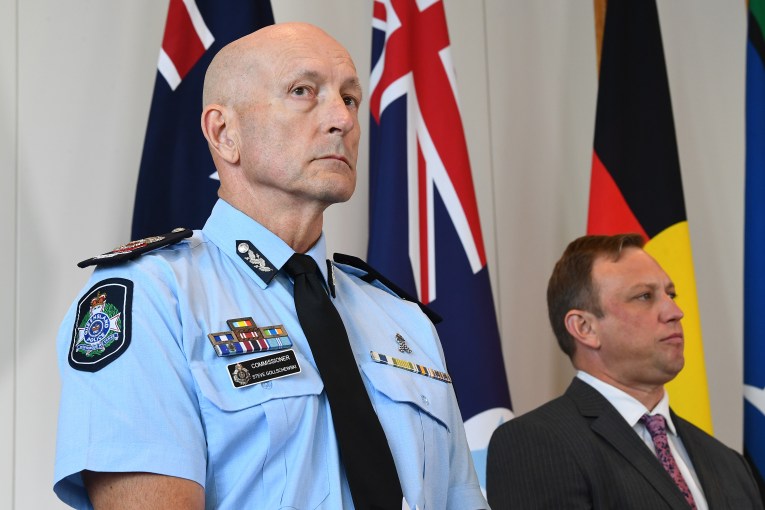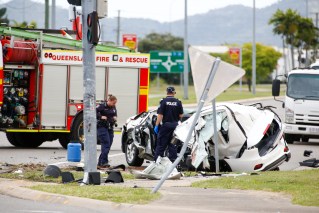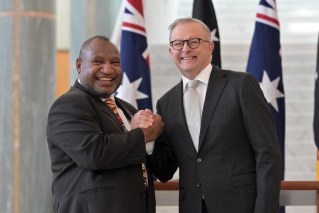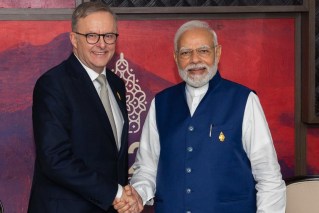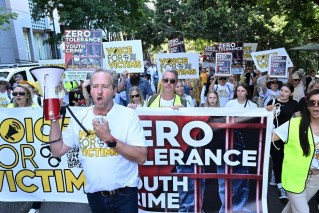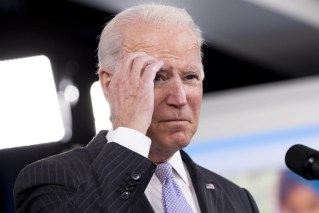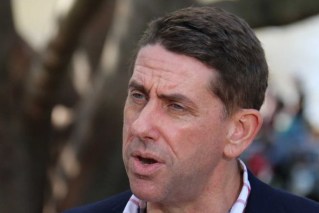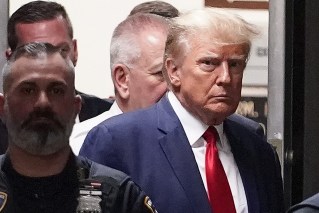A year since his historic election win, Morrison is still living dangerously
Scott Morrison tomorrow celebrates a tumultuous year since his stunning election defeat – but his legacy is yet to be established, writes Rebecca Gredley
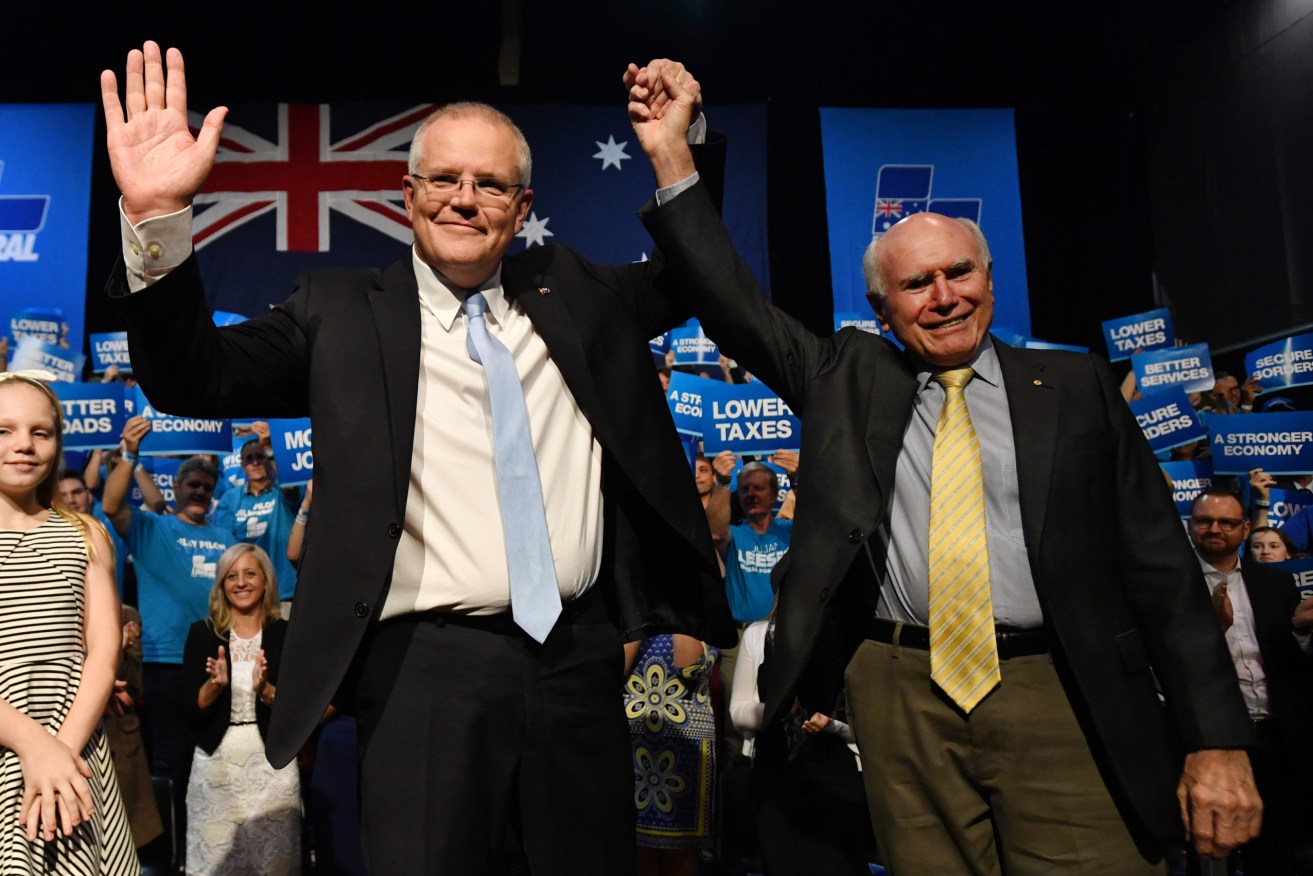
Prime Minister Scott Morrison, pictured with John Howard after his 2019 election win. (Photo: AAP Image/Mick Tsikas)
You have to flip a long way back in the history books to find political situations comparable to Scott Morrison’s 12 months since the election.
But it will be his next steps that will set the tone for his legacy as prime minister.
Political strategist Bruce Hawker says you have to look back to wartime leaders such as Liberal prime minister Robert Menzies for similar challenges to the coronavirus pandemic.
Menzies was leader during the outbreak of WWII, had a slim majority in parliament like Morrison but lost control of the House of Representatives.
“Poor management in wartime leads to a strong and negative response. Poor management during an economic crisis leads to a very negative response,” Hawker told AAP.
“And even though there aren’t any real precedents, in recent times anyway, for a virus of this nature, Morrison has to make sure that he gets his economic and fiscal responses well worked out.
“Because if he doesn’t, what we do know from history is that the public will be hard in their reaction.”
The Great Depression of 1929 to 1939 also posed similar challenges for prime ministers and saw some drop like flies because of their failures to deal with the downturn, Hawker added.
Morrison’s surprise election win on May 18 last year shows you can only implement an extensive reform agenda from government, Australian National University’s Ian McAllister says.
Morrison hit the campaign trail with a promise to bring the budget back into surplus and introduce tax cuts, and left his remaining airtime to criticise Labor’s broad policies.
“If it comes to the end of this crisis and people think the government has done well, there probably is an opportunity there to do something reasonably radical,” McAllister told AAP.
He points to Liberal prime minister John Howard’s campaign for a GST during the 1998 election.
Economist Saul Eslake expects Morrison’s post-virus agenda to move from getting the budget back into surplus to pursuing reforms that will help the economy’s ability to recover.
Eslake says the prime minister has enormous authority in the party and cabinet as a result of his unexpected victory last year.
He’s in a stronger position than Malcolm Turnbull and Tony Abbott were, Eslake adds.
Griffith University’s Anne Tiernan says one thing going for Morrison is he has no former Liberal leaders sniping at him from the back benches.
He also largely dodged political damage from Turnbull’s recent memoir because it was released amid the coronavirus pandemic.
Hawker says Morrison represents a middle ground for the Liberals, between conservative Abbott and socially progressive Turnbull.
“It’s a bit like Goldilocks and the Three Bears – this one tastes just right,” he said.
“I don’t know if that is going to last. Some of Morrison’s political instincts aren’t well thought through, that was demonstrated clearly by the mismanagement of the bushfires just a few months ago.
“COVID has given him a pass on that but he needs to be very, very careful where he goes in the coming 12 months.”
A YEAR TO REMEMBER: KEY MOMENTS IN MORRISON’S WILD RIDE SINCE ELECTION
MAY
* Scott Morrison narrowly wins election, Bill Shorten quits as Labor leader.
* Anthony Albanese is elected Labor leader uncontested.
* Morrison cabinet reshuffle keeps many of the Dutton forces in the ministry. He adds more women.
JUNE
* Morrison visits Solomon Islands, UK and Singapore to drive his Pacific Step-Up message.
* Adani’s Carmichael mine gets the federal green light.
JULY
* Morrison attends G20 summit in Japan, as the strained US-China relationship dominates talks.
* Parliament sits for first time since the election, with personal tax cuts passed.
* Morrison commits to more help for drought-hit farmers.
AUGUST
* Liberal MP Andrew Hastie triggers debate over a lack of focus on China’s military rise, comparing it to the underestimation of Nazi Germany.
* Morrison lays out plans for the public service to be more efficient and respond to the needs of middle Australia.
* Morrison heads to Tuvalu, Vietnam, France and East Timor for climate, trade and security meetings.
SEPTEMBER
* Morrison resists pressure to save a Tamil family who had been living in the Queensland town of Biloela from deportation.
* Morrison rallies behind under-fire rookie MP Gladys Liu who was forced to cut ties with organisations linked to Chinese propaganda units.
* The coalition pushes on with controversial plans to drug test welfare recipients.
* Bushfires burn in Queensland.
* Morrison receives a lavish reception from Donald Trump during a visit to the US.
* Morrison heads to regional Queensland to announce $100 million in further drought support.
OCTOBER
* Morrison confirms he agreed to help Donald Trump’s investigation into a controversial probe of Russian interference in the 2016 US presidential election.
* Morrison visits Fiji with the focus on rugby league and military cooperation rather than tensions over climate change action.
* Energy Minister Angus Taylor rejects suggestions his office doctored a document to attack Sydney’s mayor.
NOVEMBER
* China and Australia agree to work on improving relations after Morrison attends the East Asia Summit in Thailand.
* Labor’s election review finds a cluttered policy agenda, Bill Shorten’s unpopularity and a failure to adapt to Morrison was behind the party’s loss.
* The government announces more drought support including zero-interest loans and a water for fodder scheme.
* Deadly bushfires rage across NSW, sparking climate change debate.
* Coalition announces plans to bring forward billions in infrastructure spending to stimulate economy.
* Government announces $537 million for aged care after scathing royal commission report.
* Morrison government suffers a humiliating parliamentary loss with One Nation killing off its union-busting bill at the last minute.
DECEMBER
* Parliament scraps medical transfer laws for refugees.
* Morrison slashes the number of federal government departments and sacks five senior bureaucrats in a major shake-up of the public service.
* Morrison cancels family holiday after heavy criticism for going to Hawaii while horrific fires engulf large parts of the country.
* The bushfire crisis worsens across the country.
2020
JANUARY
* Morrison under attack over bushfire response, with one poll showing 57 per cent disapproval. Pledges royal commission.
* Audit report takes aim at Bridget McKenzie’s handling of sports infrastructure grants. Morrison orders an inquiry by his department boss Phil Gaetjens.
* The first coronavirus cases in Australia are confirmed.
* Australia announces plan to evacuate citizens and permanent residents stranded in Wuhan and quarantine them on Christmas Island.
FEBRUARY
* Gaetjens report finds McKenzie had a conflict of interest over a gun club membership, and recommends changes to sports grants process.
* McKenzie resigns from her leadership position and from cabinet.
* Deputy Prime Minister Michael McCormack fends off a challenge by Barnaby Joyce.
MARCH
* Australia records first coronavirus death, a 78-year-old man who contracted the disease aboard the Diamond Princess.
* Reserve Bank cuts cash rate to new record low of 0.5 per cent.
* Government announced $2.4 billion package to allow free GP consultations and create new pop-up clinics.
* First coronavirus economic stimulus package unveiled, with $22.9 billion to help welfare recipients and small businesses.
* Gatherings of 500 people or more are banned. Morrison vows to attend an NRL match before it comes into place but quickly changes his mind.
* Peter Dutton becomes first politician to test positive for virus.
* All arrivals to Australia forced to self-isolate for 14 days; cruise ships banned for an initial 30 days.
* Non-essential indoor gatherings of 100 people banned.
* Travel advice elevated to “do not travel”, the highest level.
* A national cabinet chaired by Morrison of state and territory leaders, and top health officials formed as critical decision-making body.
* RBA cuts cash rate to new record low of 0.25 per cent; $105 billion fund created to give banks more cash for loans.
* Australia bans non-citizens and non-residents from entering the country.
* May budget postponed until October.
* Staged process of shutting down non-essential services begins, including pubs, gyms cinemas and churches.
* Public gatherings restricted from 10 to two.
* Morrison announced $130 billion wage subsidy program, aiming to keep six million employed.
APRIL
* Child care for parents still using it made free.
* Total coronavirus federal government spend hits $320 billion, 16.4 per cent of GDP.
* Social distancing begins to shows results with infection rates falling.
* Newspoll shows Morrison’s approval rating is highest since Kevin Rudd in 2009.
* JobKeeper passes parliament, paving the way for $1500 fortnightly payments for millions of workers.
* Coronavirus death toll passes 50.
* Morrison urges schools to return, sparking backlash from states.
* Morrison flags restarting parts of the economy in mid-May.
* Government brings forward plans to force Google and Facebook to pay for news content.
* Foreign Minister Marise Payne launches push for global inquiry into origins of coronavirus.
* Malcolm Turnbull reopens old wounds in the Liberal Party with his explosive memoir.
* China’s ambassador threatens a consumer boycott of Australian products in response to push for virus inquiry.
MAY
* Morrison says Australia will get an “early mark” from restrictions.
* Leaders weigh up reopening New Zealand border as Jacinda Ardern joins historic national cabinet meeting.
* National cabinet unveils three-stage plan for states to work within to lift restrictions.
* States begin to lift restrictions at different paces.
* Unemployment hits 6.2 per cent.
-AAP
